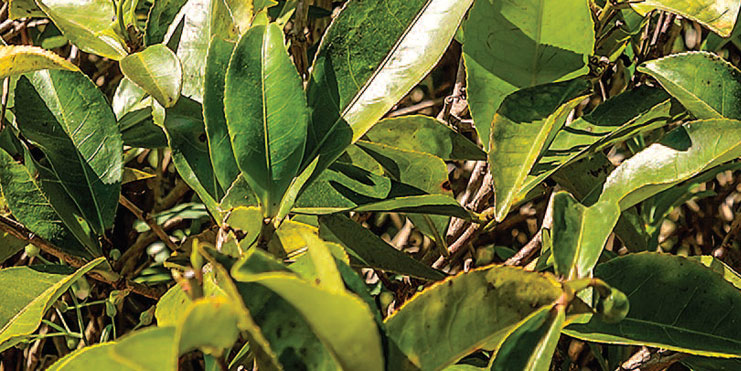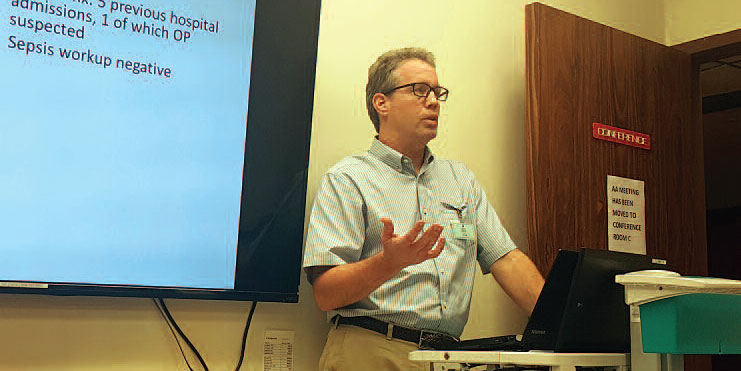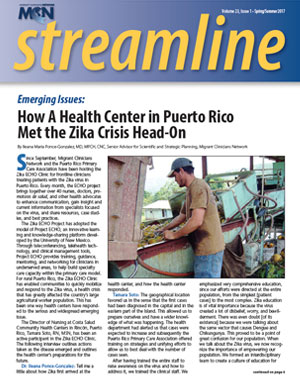In the Field: Frontline Clinicians Recognizing and Managing Pesticide Poisonings in Hawaii

[Editor’s note: This article is an expansion of a piece that originally appeared on MCN’s news blog. Go to www.migrantclinician.org/blog.html to read about MCN’s latest happenings and to sign up for updates. Go to our archived webinar page to see a recorded webinar by Dr. Jimmy Roberts: http://www.migrantclinician.org/services/education/pastwebinars.]
In January 2016, 19 agricultural workers on the Hawaiian island of Kauai re-entered a crop research field owned by seed giant Syngenta Seeds. The field had been recently sprayed with chlorpyrifos, a toxic organophosphate banned for household use but is the most used conventional insecticide in agriculture in the US.1 Ten of the workers became too ill to work, and were transferred to the hospital for treatment. Unfortunately, agricultural workers in the US remain at risk to exposures like these from pesticides. Clinicians are often poorly equipped and have limited education regarding the recognition and management of pesticide poisonings. However, with sufficient clinician training and support, medical providers can help workers recover, report exposures, provide workers with education on their rights and ways to protect themselves, and help assure that fewer exposures will happen in the future. In March, through an onsite continuing education training at the Kauai Veterans Memorial Hospital in Hawaii, Migrant Clinicians Network stepped up to ensure that clinicians throughout Kauai including the first responders, hospital clinicians, and the providers at the local health center have the tools, training, and strong networks to effectively address such poisonings, should workers or residents ever be poisoned again.
“It was a real honor to be part of the solution to address the health care needs regarding the recognition and management of pesticide poisonings,” said Amy K. Liebman, MPA, MCN’s Director of Environmental and Occupational Health, who organized the training and technical assistance as part of MCN’s environmental and occupational health program, sponsored by the Environmental Protection Agency (EPA).
Chlorpyrifos, the broad-spectrum insecticide that poisoned the workers in Hawaii, is an acetylcholinesterase inhibitor, which reduces the transmission of signals through the nervous system. Research has indicated that very low-level prenatal exposure to chlorpyrifos is correlated with brain development disruption including a decrease in IQ, attention deficit disorders, working memory issues, and developmental delays in children.2,3,4 Low-dose exposure of chlorpyrifos among agricultural workers can result in headaches, nausea, inability to concentrate, weakness, and fatigue. Additionally, organophosphate exposure among agricultural workers is associated with poor neurobehavioral test results.5 Chlorpyrifos is widely used in agriculture and on turf lawn. Earlier this year, the EPA declined a petition to ban chlorpyrifos in agriculture. (You can read MCN’s article on chlorpyrifos in the Winter/Spring issue of Streamline at https://goo.gl/oahWud.)
For this training, MCN’s expertise was paired with one of the leading experts on the frontlines of the clinical responses to pesticide poisonings. Joining Liebman and serving as the lead faculty for the training was Jimmy Roberts, MD, MPH, co-author of the EPA’s Recognition and Management of Pesticide Poisonings, 6th Edition (RMPP), the seminal reference guide for clinicians treating a pesticide exposed patient, and host of MCN’s recent webinar on pesticide exposures among agricultural workers.

Dr. Roberts leading a session on the recognition and management of pesticide poisoning in Hawaii.
Dr. Roberts and Liebman worked with Kauai clinicians to begin to establish a clear and agreed-upon protocol on treatment, data collection, care coordination, and other critical aspects of care during a pesticide poisoning event. The West Kauai Medical Center is now developing a workplan with MCN’s technical assistance to address pesticide exposure concerns, Liebman said.
A second day of training, co-sponsored by the Hawaii Department of Health, the Hawaii Chapter of the American College of Emergency Physicians, and Hawaii Emergency Physicians Associated, brought Liebman and Dr. Roberts to Oahu, to further integrate pesticide awareness and response to all levels of Hawaiian clinicians. “These smaller rural emergency departments are critical for the management of pesticide exposure,” Liebman noted. She emphasized that emergency physicians can improve an exposed worker’s health outcome if properly trained and equipped to recognize and manage pesticide poisoning.
MCN was invited by EPA’s Region IX, which covers California, Nevada, Arizona, and Hawaii. “Migrant Clinicians Network’s training in Kauai and Oahu provided individuals with valuable training and it also initiated medical providers and state agencies to work on how they can improve their response to a pesticide poisoning.” said Amy Miller, Senior Policy Advisor of the Office of Regional Administrator at EPA’s Region IX.
On April 20, Dr. Roberts offered an MCN-sponsored national webinar on the recognition and management of pesticide poisonings, in which participants received some of the same critical training that Dr. Roberts and Liebman provided in-person in Hawaii. The webinar is now archived on the MCN site. Participants may receive continuing medical or nursing education credits for viewing the archived webinar. Visit http://www.migrantclinician.org/services/education/pastwebinars to view all of our recent webinars.
Resources:
- Learn more about MCN’s environmental and occupational health program at https://goo.gl/rNBbSf.
- View online or order a free copy of the EPA book, Recognition and Management of Pesticide Poisonings, 6th edition, at https://goo.gl/yr53qi.
- Visit MCN and Farmworker Justice's Pesticide Reporting Map to see state-by-state pesticide regulations and how to report pesticide exposures at https://goo.gl/W6QhZK.
References:
- Chlorpyrifos Status Update. Pesticide Program Dialogue Committee; May 18, 2016. Available at: https://www.epa.gov/sites/production/files/2016-05/documents/session-2-chlorpyrifos-human-health-risk-assessment-approach.pdf
- Rauh VA, Perera FP, Horton MK, et al. Brain anomalies in children exposed prenatally to a common organophosphate pesticide. Proc Natl Acad Sci USA. 2012;109(20):7871-6. Available at: http://www.pnas.org/content/109/20/7871.full
- Rauh V, Arunajadai S, Horton M, et al. Seven-year neurodevelopmental scores and prenatal exposure to chlorpyrifos, a common agricultural pesticide. Environ Health Perspect. 2011;119(8):1196-201. Available at: https://ehp.niehs.nih.gov/1003160/
- Shelton JF, Geraghty EM, Tancredi DJ, et al. Neurodevelopmental disorders and prenatal residential proximity to agricultural pesticides: the CHARGE study. Environ Health Perspect. 2014;122(10):1103-9. Available at: https://ehp.niehs.nih.gov/1307044/
- Farahat TM, Abdelrasoul GM, Amr MM, et al. Neurobehavioural effects among workers occupationally exposed to organophosphorous pesticides. Occ and Environ Med. 2003;60:279-286. Available at: http://oem.bmj.com/content/60/4/279
The material presented in this portion of Streamline is supported by a grant from the Environmental Protection Agency, Office of Pesticide Programs, Grant # x8-83487601.
Read this article in the Spring/Summer 2017 issue of Streamline here!
Sign up for our eNewsletter to receive bimonthly news from MCN, including announcements of the next Streamline.
Return to the Streamline Spring/Summer 2017 Table of Contents.
